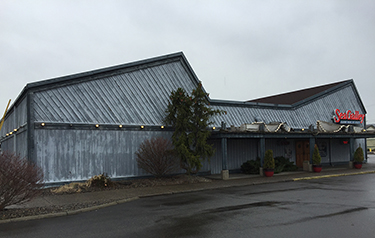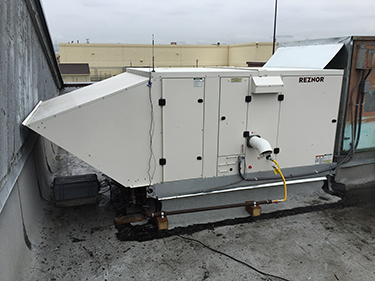|
Subscribe / Renew |
|
|
Contact Us |
|
| ► Subscribe to our Free Weekly Newsletter | |
| home | Welcome, sign in or click here to subscribe. | login |
Construction
| |
 |
May 12, 2016
Taming energy hogs with efficient HVAC units
Cascade Natural Gas

Cowlishaw
|
What’s that on the roof? Is it a bird? Is it … Santa? Nope, it’s a high-efficiency condensing rooftop HVAC unit, and to this restaurant’s operator it’s almost as exciting as Christmas.
The art of running a business is a constant juggling act between achieving profit and offsetting expenses. One of the ways a utility can help business owners reduce those expenses is by encouraging facility operators and owners to evaluate energy use and patterns.
Specifically, how effective is the equipment and building envelope and where are the opportunities for improvement and reducing usage?
This unassuming piece of HVAC equipment is part of a pilot effort to verify and increase energy savings potential for condensing models. It’s not unusual to see rooftop HVAC units sprinkled across flat roofs on commercial properties throughout the Northwest, but this unit is special because of its condensing nature and inherent efficiencies.
It is an example of the pilot efforts funded through an $18.3 million Natural Gas Market Transformation Collaborative run through the Northwest Energy Efficiency Alliance (NEEA). Funding and joint direction are provided by regional natural gas utilities and partners including Cascade Natural Gas, Avista Utilities, Energy Trust of Oregon, NW Natural and Puget Sound Energy.
Electric-focused efforts of this nature have been in place for quite some time, but the regional efforts of the collaborative are new for the natural gas industry. Natural gas rebate programs provided through the utilities are standard offerings. These regional market transformation efforts are now working in tandem with existing efficiency programs.
One such rooftop HVAC unit was installed by a local contractor, Thermex Valley Heating and AC, at a SeaGalley restaurant in Union Gap, which is in Cascade’s service territory.
The pilots are being installed in coordination with the Gas Technology Institute by HVAC contractors. While there are no guarantees of precise energy savings due to the pilot nature of the efforts, the expectation is savings in the range of 15 to 20 percent due to the original unit’s 75 percent efficiency and the new unit’s 91 percent efficiency rating.
The need to reduce utility costs is especially evident for those in the restaurant industry like Steve Hart, managing partner of the SeaGalley restaurant in the Yakima Valley. His business seats more than 300 people in an open floor plan of roughly 7,000 square feet in a 35-year-old building.
Hart says utility management for any industry — especially restaurants in older buildings — is fundamental as their very nature is that of an energy hog. He further elaborates that having a plan to reduce usage and monitor overall consumption is imperative to continued operations under the increase in the cost of energy over the past 15 years or so.
“As a matter of strategic planning to compete and to stay relevant, when it comes to the concept of a restaurant that I have, energy consumption is listed in that plan,” Hart said. “It’s a real priority for us to address these kinds of issues.”
When asked what the overarching reason was to engage in the pilot program, Hart said bill savings through energy management. “In this day, without addressing these issues, it could put us out of business,” he said.
“It’s definitely a dollars and cents issue, and so they need to be managed. In the good old days they didn’t care and it didn’t really add up to much as it was an insignificant impact on our bottom line,” Hart said.
In the last five to 10 years utility expenses have become more prevalent and require a conscious effort by employees to manage when equipment and lights are turned on, where thermostats are set and to look for opportunities of this nature as they arise.
The timing for Hart to participate in the pilot was ideal as he was already looking for viable heating upgrade options. As a prudent business operator he has a wish list of improvements for his facility and the contractor, whom he had worked with previously on a water heater upgrade, heard about the NEEA pilot and connected him with the collaborative.
While savings aren’t guaranteed with the pilot, Hart feels anything is worth striving for.
“We’re such heavy energy users you really have to kind of go out on a limb and have faith that what you’re doing is the smart thing to do,” he said.
As mentioned previously, rebate offerings are one form of incentive typically offered through the utilities to encourage businesses to upgrade to higher-efficiency equipment. Although pilot equipment of this nature is not immediately eligible for a rebate, once a piece of equipment’s potential saving and performance can be verified, utilities run cost benefit analysis and can establish rebates.
Hart agrees that rebates can be a driving factor to encourage installation of equipment above standard efficiency, but that the return on investment achieved through lower energy bills is enough to convince him to install higher-efficiency equipment even with higher initial costs.
“As a pilot program, I hope that the information that is gathered from it is valuable,” Hart said.
“Whether there’s some sort of assistance and help through rebates, or pilot programs … you need to really take advantage and stay abreast of what’s going on. You need to be able to collaborate and partner up with others — in this case a utility. When the opportunity arises and Cascade Natural Gas comes knocking at my door, I’m all ears, I’ll listen.”
Initial NEEA study results are due out this fall, which will help drive further efforts by the collaborative to increase availability and viability of these units to the region’s businesses.
Monica J. Cowlishaw is manager of Energy Efficiency & Community Outreach for Cascade Natural Gas. Her duties focus on facilitation, support and growth of energy efficiency and demand-side management in Washington and Oregon.
Other Stories:
- Another looming industry shortage: leaders
- Specialty Contracting Exterior
- Specialty Construction
- Specialty Construction Demolition
- Tenant Improvement/Renovation
- Survey: Rush Companies
- Survey: The Walsh Group
- Survey: Lease Crutcher Lewis
- Survey: Swinerton Builders
- Survey: Adolfson & Peterson Construction
- Survey: Skanska
- Specialty Contracting Interior
- Mechanical Construction
- Mixed-Use Construction
- 3 keys to managing on-the-job injuries
- Top 10 equipment acquisition trends for 2016
- Does your fall protection plan start at the top?
- WSDOT finishing ‘The Rest of the West’ on SR 520
- IPD takes preconstruction to the next level
- Eagle of Excellence • Multifamily Construction
- Commercial Construction ($1 million to $5 million)
- Community/Public Service
- Historic Preservation/Restoration
- Industrial Construction
- Survey: Hoffman Construction Co.




